Insights
INSIGHTS
All Topics
My Account
Best practices for digital mentors
06 Jun 2022by Christine Chiu
Learn how to impress your volunteers and beneficiaries with mentoring best practices
Digital mentoring is growing in popularity. As charities shift service delivery to digital from in-person, volunteering is following suit. To make an impact for both beneficiaries and volunteers, we share our digital mentoring best practice and tips.
Be clear about what you’re trying to achieve
When designing a mentoring scheme, the University of Sussex says the first step is to define the purpose. For charities, digital volunteering and mentoring schemes offer opportunities to develop relationships.
For example, Brightside offers a chance to be an online mentor. The role includes growing a relationship with a young person through sharing experience and wisdom. Our top tip here is to include your objectives in your advert, so that new joiners understand what the goals are.
Establish and review expectations
Have an open and honest conversation with your mentees and mentors. Let them know what they can expect and when. You may want to include how often you would like mentors to submit digital reports, or how many emails are to be exchanged over a week.
For mentees, it’s important for them to understand what they can expect from digital mentors in terms of frequency and over what digital platform.
Our top tip here is to provide examples of what constitutes an ideal relationship.
Use technology to your advantage
2Civility, a US-based lobby group, says to use technology strategically. They suggest exploring the right tech tool for meetings, chats, and more formal communications.
Our top tip is to review the cache of digital tools we’ve examined for hybrid and digital working. Don’t forget, platforms like Microsoft Teams and Slack can be leveraged.
Train your mentors
To ensure that mentors feel supported, make sure to offer them guidance. To get started, review Be Connected’s digital library. The Australian government’s network partner includes free videos on how to be a good online mentor and builds on digital facilitation skills.
Our top tip here is to launch an induction first, followed by regular updates during the mentoring programme. That way, your mentors are always on point when it comes to training and development.
Making suitable matches
For most mentorship and volunteering programmes, matches need to be made with beneficiaries. There may be many factors going into the process.
Birkbeck University says that it “is necessary to carefully consider the mentee’s position and needs, and the mentor’s profile, and try to build pairs where both mentor and mentee can get the most [out of the relationship]”.
In addition to reviewing applications, charity digital managers might also want to have one-on-one chats with candidates to make sure that the right fit is found.
Make good filing part of the process
When running a mentorship programme, don’t forget about the paperwork. To start with, you’ll need to save participant agreements. This includes those between the charity and mentor, charity and mentee, and mentor and mentee.
The Prince’s Trust sets out the basics for success when it comes to documentation. They suggest drafting a mentorship agreement, goals, worksheets, and reports.
Within these documents, charities outline how the programme works, partnership goals, and what the rules are around participating. There may also be reports documenting mentoring sessions or how the relationship is progressing.
Our top tip here is to use cloud storage, so that everyone can access the documents as and when required.
Recognise milestones and achievements
To keep your programme participants engaged, recognise milestones and achievements. You may want to have regular digital or in-person meetings with both mentors and mentees to assess how the relationship is going.
During milestone meetings, take stock of the regular reports against the ambitions of the relationship. Our top tip here is to mark achievements both digitally and in person. You may want to issue certificates or digital cards to memorialise events.
Feedback is important
Gathering feedback is part of mentoring best practice. Ensure that you have a dedicated channel to gathering feedback from both the mentor and mentee. Use a CRM system or volunteer management system to help you identify and manage trends.
Celebrations are a must
Last, celebrate achievements with your mentors and mentees. You may want to include a graduation ceremony or festivity at the end of your mentorship agreement with both parties. Our top tip here is to ensure that you’ve documented the event.
You may want to include photos, diary entries or video content on your website and social media pages to entice other candidates to sign up.
More on this topic
07 Mar 2025by Laura Stanley
An introvert’s guide to networking
27 Feb 2025by Laura Stanley
Charity Spotlight: Dr Anton Mari Lim, President, Yellow Boat of Hope Foundation
Recommended Products
Our Events
Charity Digital Academy
Our courses aim, in just three hours, to enhance soft skills and hard skills, boost your knowledge of finance and artificial intelligence, and supercharge your digital capabilities. Check out some of the incredible options by clicking here.















